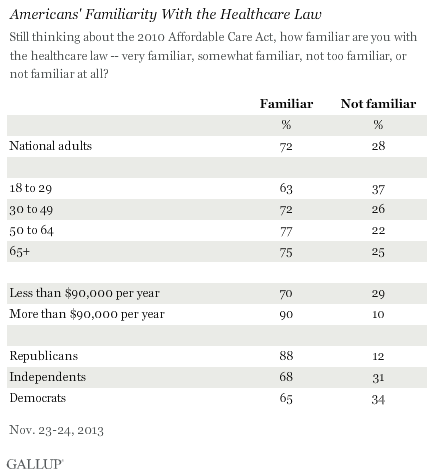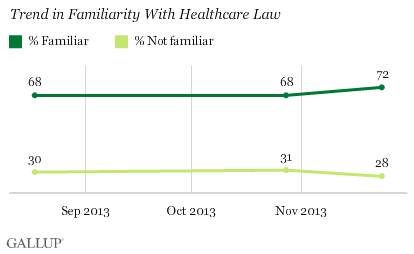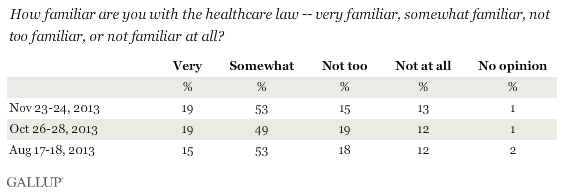PRINCETON, NJ - Americans younger than 30, a key group targeted by the Affordable Care Act, continue to be the least familiar with it. Another important group, those with lower incomes, are less familiar with the healthcare law than are those with higher incomes.

The new healthcare law's success will rest at least partially on young Americans' enrollment rates, given the need to have uninsured but healthy younger people sign up for insurance to help subsidize the cost of healthcare for those who are older and more likely to require benefits. These young people need to be familiar with the law if they can be expected to respond to its mandate requiring them to have insurance. There is clearly still work to be done on that front -- with younger Americans significantly less acquainted with the law than those who are older.
The law, also known as Obamacare, is intended to benefit those with lower incomes, who are more likely to be uninsured than those with higher incomes. But at this time, lower-income Americans are less familiar with the law.
Although the healthcare act originated with a Democratic president and was passed by a Democratic-controlled Congress in 2010, Republicans across the country are significantly more familiar with it than are Democrats. This could reflect the desire among those who are most emotionally opposed to the law to know more about it, or underlying differences in attention to news across party groups.
Familiarity Little Changed
Overall, familiarity with the healthcare law is up only slightly from late summer and October, with 72% now saying they are at least somewhat familiar with the law, while 28% say they are not.

The majority of those who are familiar with the law fall into the "somewhat" familiar rather than the "very" familiar category, perhaps not a surprising finding given the law's complexity and that many of its features are still being rolled out.

Those Who Are Familiar Are Most Opposed
Those who are familiar with the healthcare law are significantly more likely to oppose it than those who are not familiar with it. Among those familiar with the law, net approval is -19 percentage points, slightly more negative than is the case for the overall population. Those who are unfamiliar with the law are evenly divided, with 41% approving and 43% disapproving.

These relationships do not necessarily mean acquaintance with the law leads one to become more negative, as the correlations most certainly reflect party differences in familiarity. Still, it is possible that if familiarity with the law increases, opinions could shift at least somewhat in a more negative direction, given the higher disapproval among the familiar population.
Bottom Line
The majority of Americans remain broadly familiar with the healthcare law, but relatively few claim to be "very" familiar with it. Two groups that the law is most likely to affect -- young Americans and those with lower incomes -- remain less familiar than others.
Survey Methods
Results for this Gallup poll are based on telephone interviews conducted Nov. 23-24, 2013, on the Gallup Daily tracking survey, with a random sample of 1,034 adults, aged 18 and older, living in all 50 U.S. states and the District of Columbia.
For results based on the total sample of national adults, the margin of sampling error is ±4 percentage points at the 95% confidence level.
Interviews are conducted with respondents on landline telephones and cellular phones, with interviews conducted in Spanish for respondents who are primarily Spanish-speaking. Each sample of national adults includes a minimum quota of 50% cellphone respondents and 50% landline respondents, with additional minimum quotas by region. Landline and cell telephone numbers are selected using random-digit-dial methods. Landline respondents are chosen at random within each household on the basis of which member had the most recent birthday.
Samples are weighted to correct for unequal selection probability, nonresponse, and double coverage of landline and cell users in the two sampling frames. They are also weighted to match the national demographics of gender, age, race, Hispanic ethnicity, education, region, population density, and phone status (cellphone only/landline only/both, and cellphone mostly). Demographic weighting targets are based on the March 2012 Current Population Survey figures for the aged 18 and older U.S. population. Phone status targets are based on the July-December 2011 National Health Interview Survey. Population density targets are based on the 2010 census. All reported margins of sampling error include the computed design effects for weighting.
In addition to sampling error, question wording and practical difficulties in conducting surveys can introduce error or bias into the findings of public opinion polls.
View methodology, full question results, and trend data.
For more details on Gallup's polling methodology, visit www.gallup.com.
